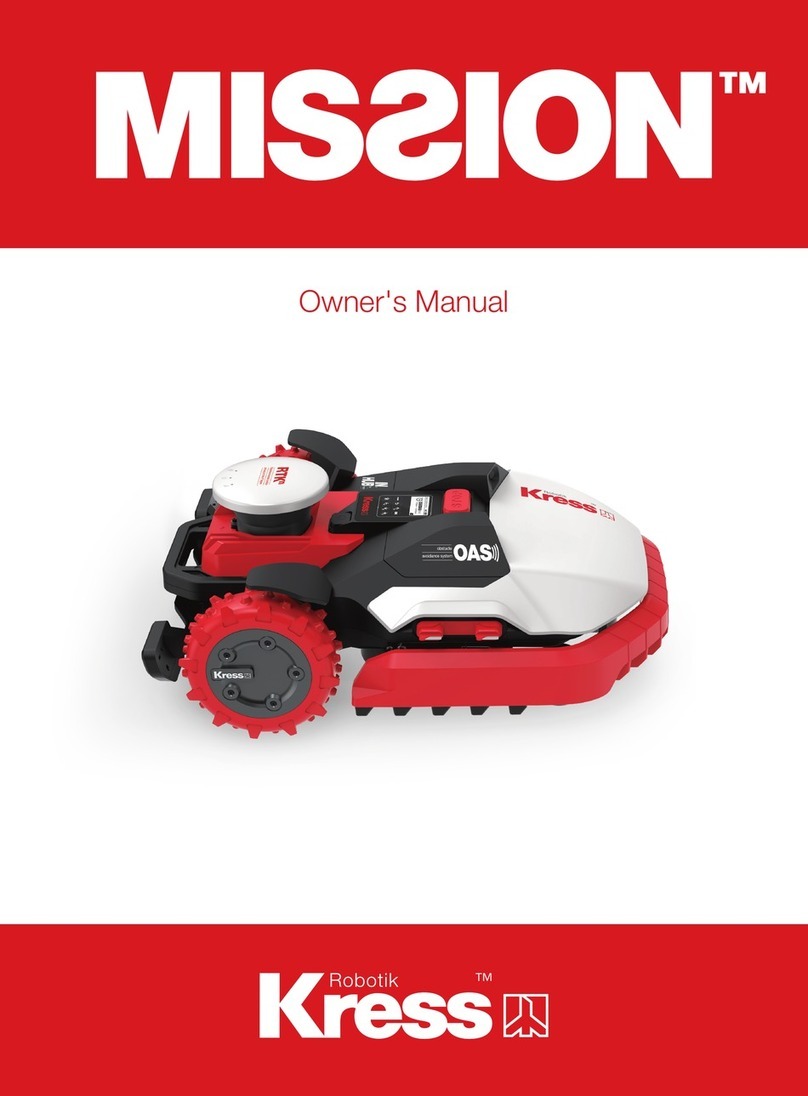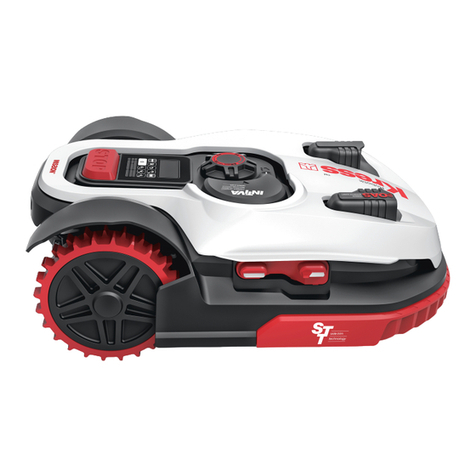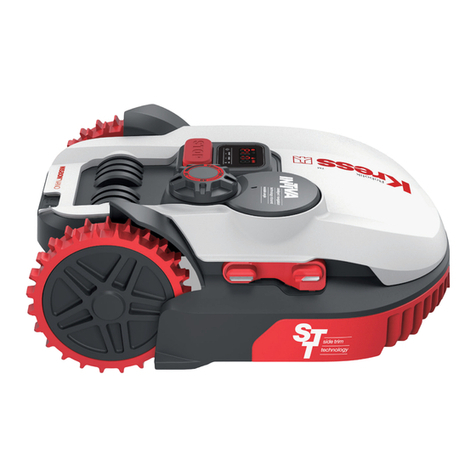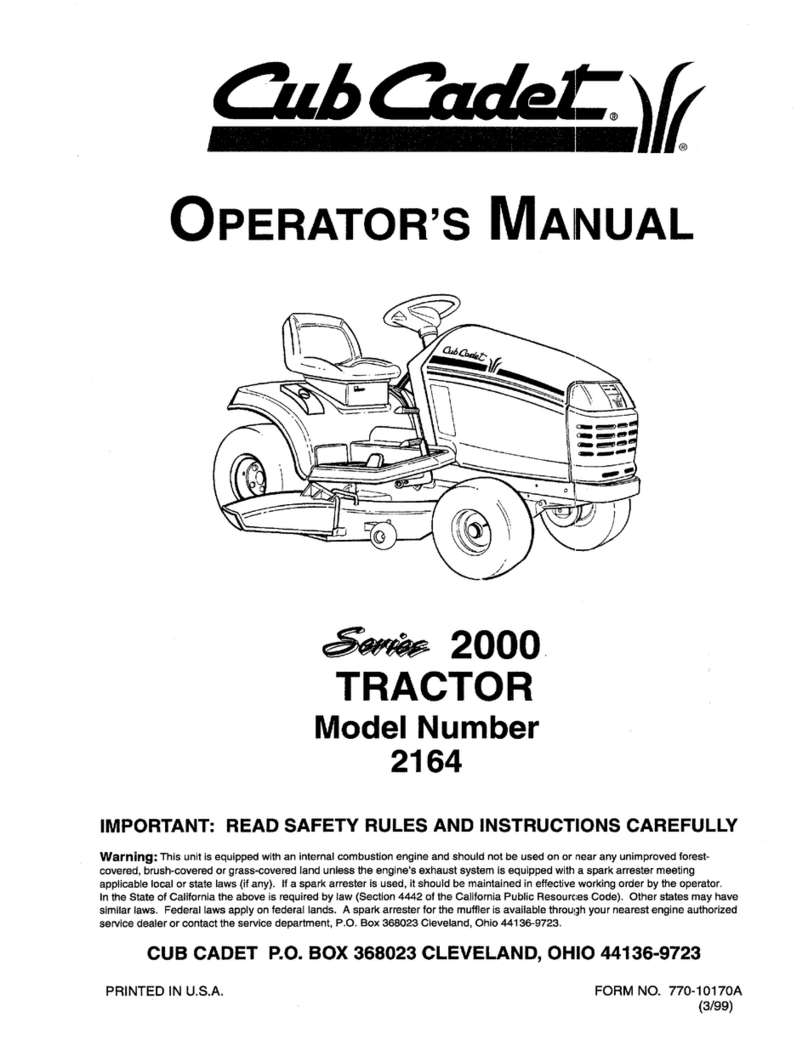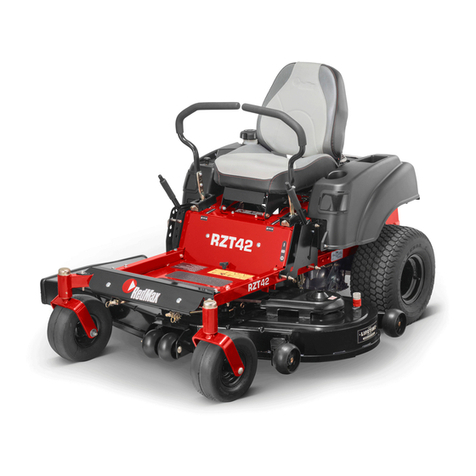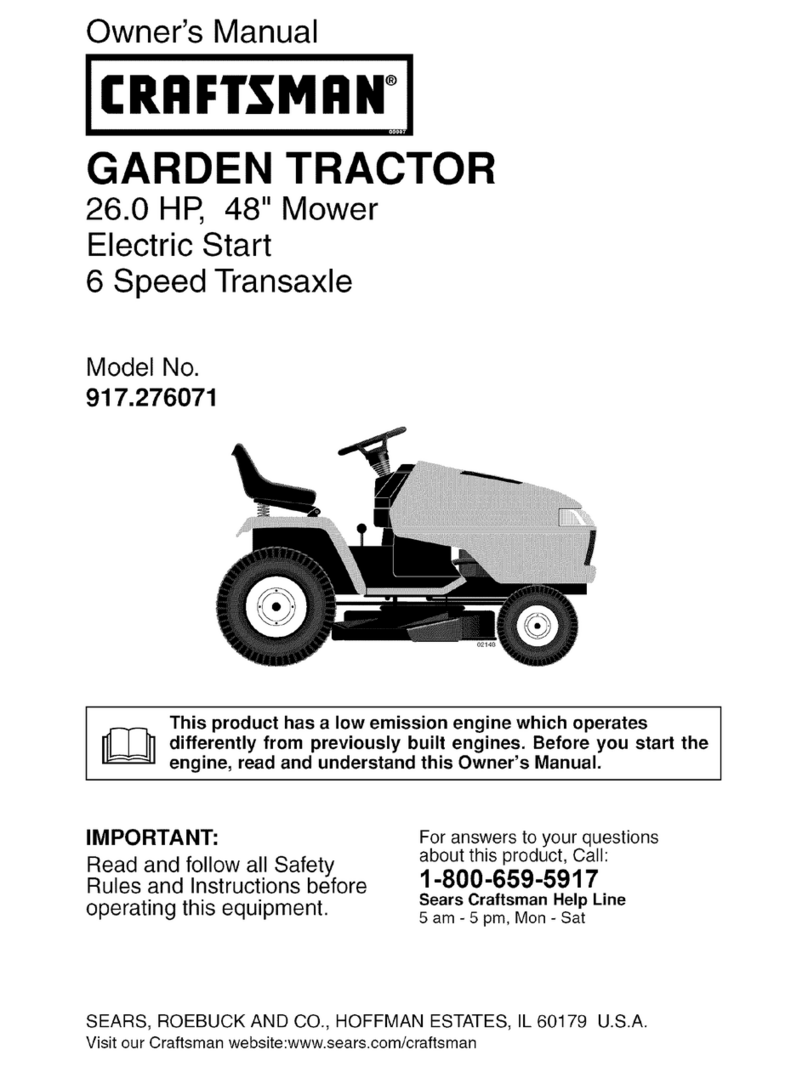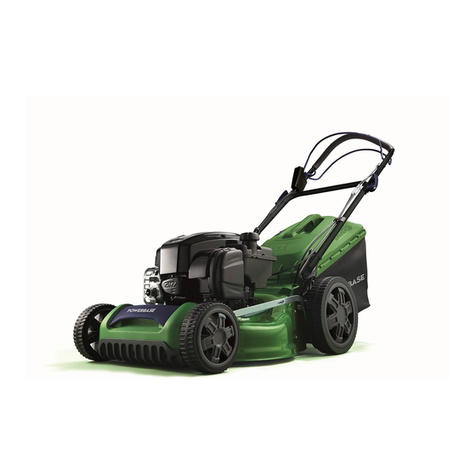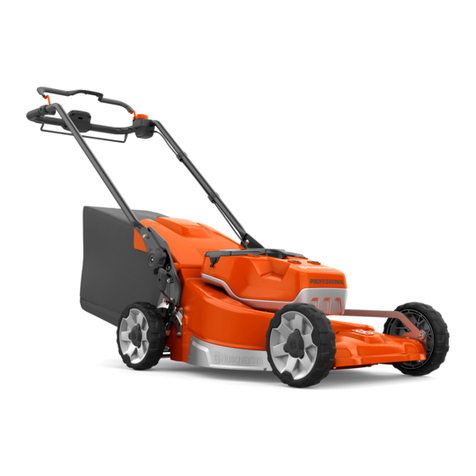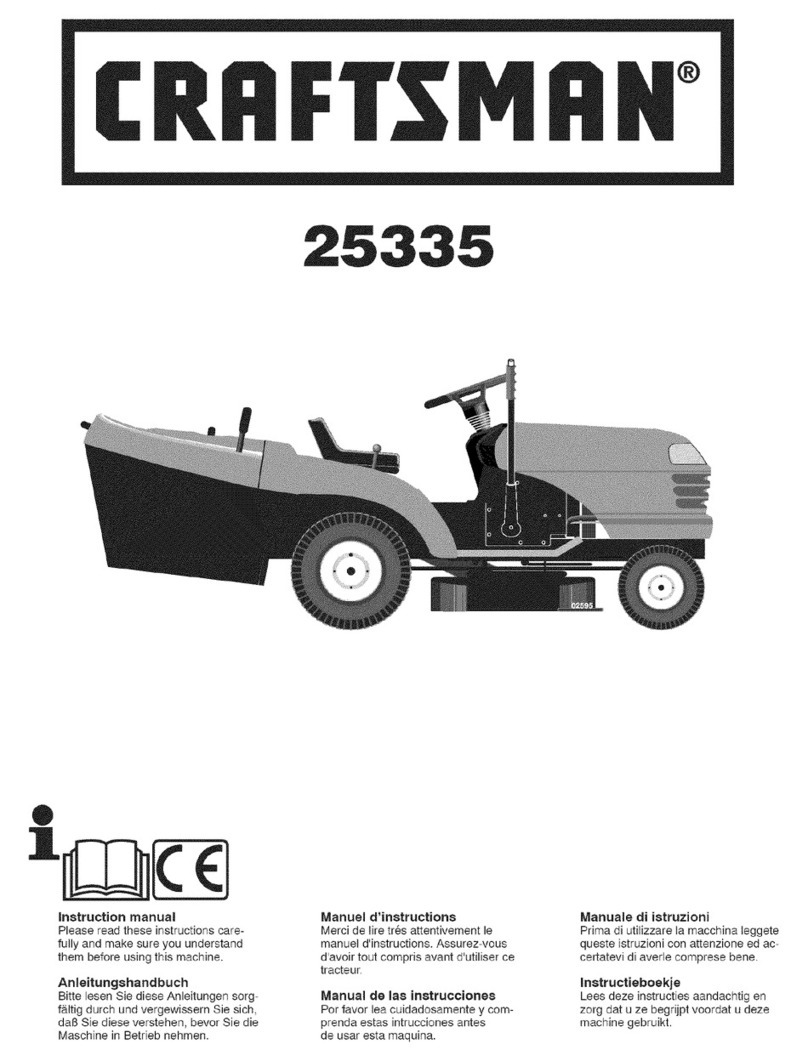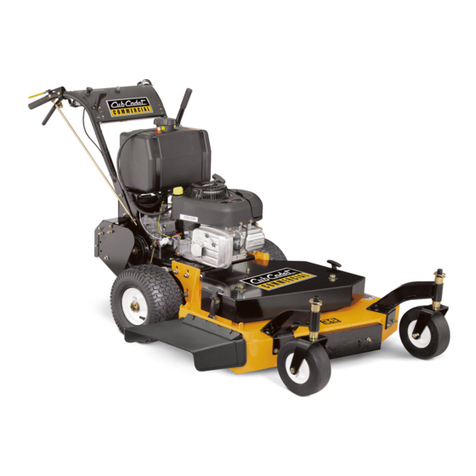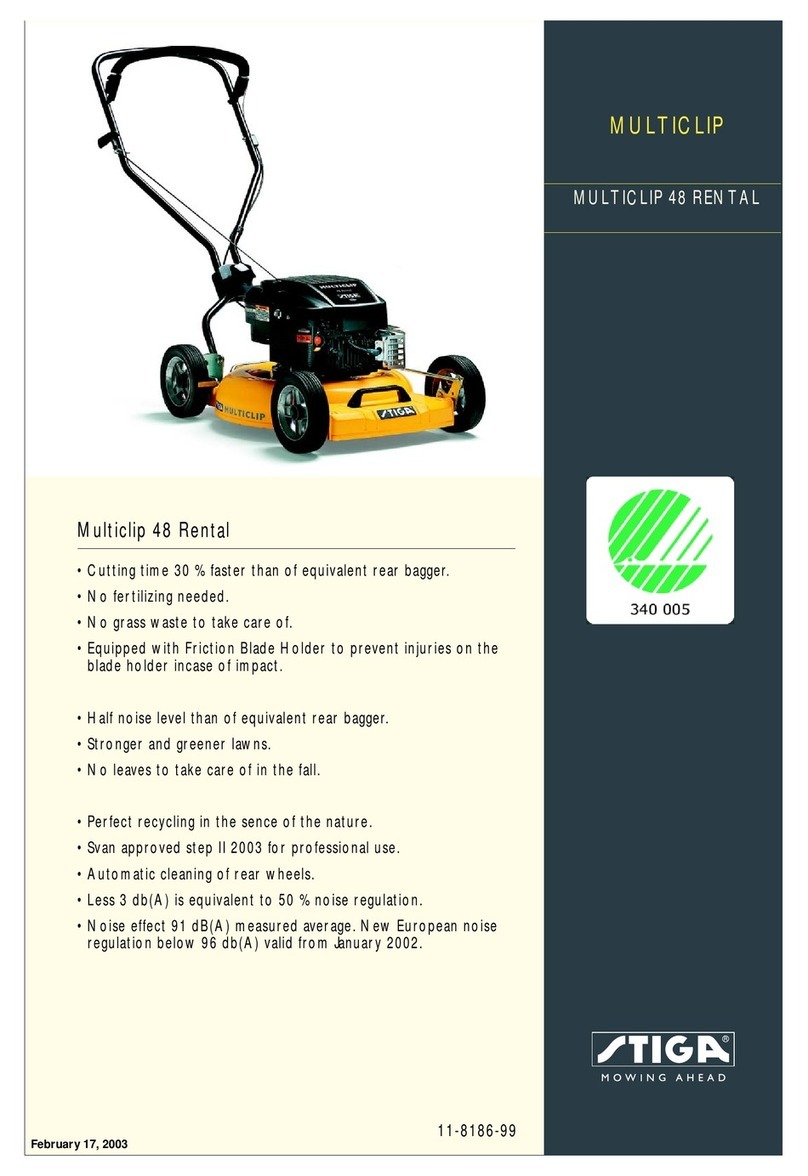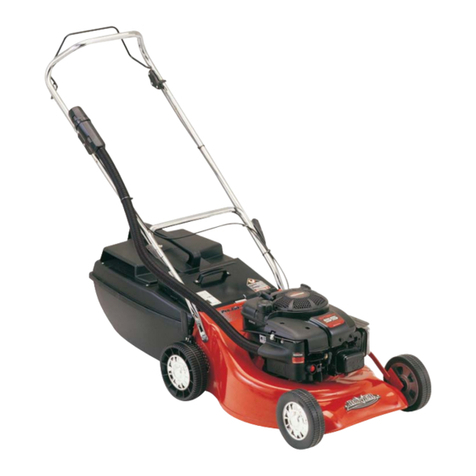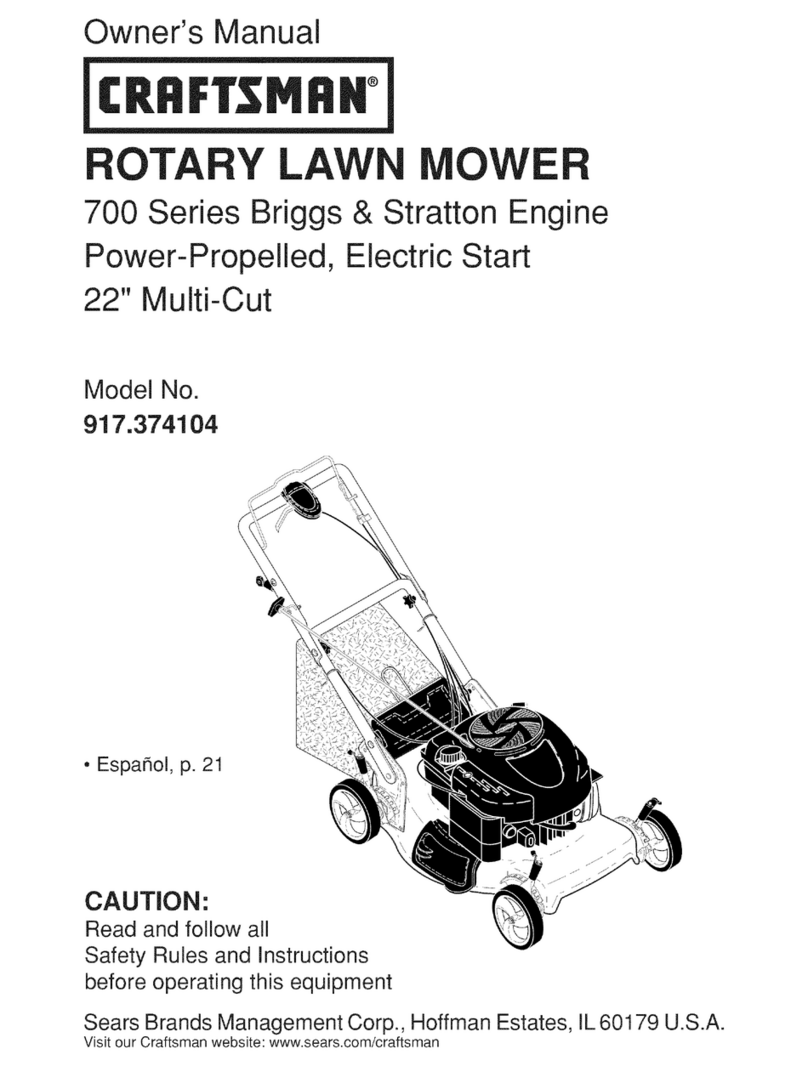Kress Robotik Mission RTKn 2000 User manual

Owner's Manual

Owner's Manual P03
Benutzerhandbuch P17
Mode d’emploi P33
Manuale d'uso P48
Manual del propietario P63
Gebruikershandleiding P78
Instrukcja obsługi P93
Instruktionsbog P108
Brukermanuel P122
Bruksanvisning P136
K R172 E K R173 E K R174 E
En
De
Fr
I
Es
Nl
Pl
Dk
Nor
Sv
En
De
Fr
I
Es
Nl
Pl
Dk
Nor
Sv
Original instructions
Originalbetriebsanleitung
Notice originale
Istruzioni originali
Manual original
Oorspronkelijke gebruiksaanwijzing
Instrukcja oryginalna
Original brugsanvisning
Original driftsinstruks
Original instruktioner

3
EN
Product safety
General safety warnings
WARNING: Read all safety warnings
and all instructions.
Failure to follow the
warnings and instructions may result in electric
shock, fire and/or serious injury.
Carefully read the instructions for the safe
operation of the machine.
Save all warnings and instructions for
future reference.
- This appliance is not intended for use by
persons (including children) with reduced
physical, sensory or mental capabilities,
or lack of experience and knowledge,
unless they have been given supervision or
instruction concerning use of the appliance
by a person responsible for their safety.
- Children should be supervised to ensure that
they do not play with the appliance.
- This appliance contains batteries that are only
replaceable by skilled persons.
WARNING: For the purposes of recharging
the battery, only use the detachable supply
unit provided with this appliance.
IMPORTANT
READ CAREFULLY BEFORE USE
KEEP FOR FUTURE REFERENCE
Safe operation practices
Training
a) Read the instructions carefully. Make sure you
understand the instructions and be familiar
with the controls and the proper use of the
appliance.
b)
Never allow people unfamiliar with these
instructions or children to use the appliance.
Local regulations can restrict the age of the
operator.
c) The operator or user is responsible for
accidents or hazards occurring to other
people or their property.
Preparation
a) Confirm that the virtual boundary is
established as instructed and the virtual
boundary is regularly maintained. Before each
working cycle, the machine goes around the
working area to check whether the virtual
boundary exists, if it does not exist, the
machine will shut down. The virtual boundary
specifies the work area where the machine
is allowed to operate. The RTK antena in the
machine senses when it is approaching the
virtual boundary. When the machine hits an
obstacle or approaches the virtual boundary
the product selects a new direction.
b) Periodically inspect the area where the
appliance is to be used and remove all
stones, sticks, wires, bones, and other
foreign objects.
c) Periodically visually inspect to see that the
blades, blade bolts and cutter assembly
are not worn or damaged. Replace worn or
damaged blades and bolts in sets to preserve
balance.
d) On multi-spindle appliances, take care as
rotating one blade can cause other blades to
rotate.
e) WARNING! The lawnmower shall not be
operated without the guard in place.
Operation
1. General
a) Never operate the appliance with defective
guards, or without safety devices, for
example deflectors, in place.
b) Do not put hands or feet near or under
rotating parts. Keep clear of the discharge
opening at all times.
c) Never pick up or carry an appliance while the
motor is running.
d) Operate the disabling device from the
appliance
- Before clearing a blockage;
- Before checking, cleaning or working on the
appliance;
- After striking a foreign object to inspect the
machine for damage;
-If the machine starts to vibrate abnormally,
and to check for damage before restarting.
e) It is not permitted to modify the original
design of robotic lawnmower. All
modifications are made at your own risk.
f) Start robotic lawnmower according to the
instructions. When the power is on, make
sure you keep your hands and feet away from
the rotating blades. Never put your hands
and feet under the mower.
g) Never lift up robotic lawnmower or carry it
when the power is on.
h) Do not let persons who do not know how
robotic lawnmower works and behaves use
the mower.
i) Do not put anything on top of robotic
lawnmower or its charging base.
j)
Do not allow robotic lawnmower to be used
with a defective blade disc or body. Neither
should it be used with defective blades,

4
EN
screws, nuts or cables.
k)
Always switch off robotic lawnmower when
you do not intend to use the mower. Robotic
lawnmower can only start when the power
is on and the correct PIN code has been
entered.
l) Keep your hands and feet away from the
rotating blades. Never place your hands or
feet close to or under the body when robotic
lawnmower is in operation.
m)To avoid using the machine and its
peripherals in bad weather conditions
especially when there is a risk of lightning.
n) Not to touch moving hazardous parts before
these have come to a complete stop.
o) For machines used in public areas, that
warning signs shall be placed around the
working area of the machine. They shall show
the substance of the following text:
Warning! Automatic lawnmower! Keep away
from the machine! Supervise children!
2. Additionally when the appliance is
operating automatically
a) Do not leave the machine to operate
unattended if you know that there are pets,
children or people in the vicinity.
Maintenance and storage
WARNING! When the mower is turned
upside down the power must always
be off.
The power should be off during all work on
the mower’s underframe, such as cleaning
or replacing the blades.
a) Keep all nuts, bolts and screws tight to
be sure the appliance is in safe working
condition.
b) Inspect the robotic lawnmower each week
and replace worn or damaged parts for
safety.
c) Check especially that the blades and blade
disc are not damaged. Replace all blades and
screws at the same time if necessary so that
the rotating parts are balanced.
d) Ensure that only replacement cutting means
of the right type are used.
e) Ensure that batteries are charged using
the correct charger recommended by the
manufacturer. Incorrect use may result in
electric shock, overheating or leakage of
corrosive liquid from the battery.
f) In the event of leakage of electrolyte flush with
water/neutralizing agent, seek medical help if
it comes into contact with the eyes etc.
g) Servicing of the appliance should be
according to manufacturers’ instructions.
Recommendation
To connect the machine and/or its peripherals
only to a supply circuit protected by a residual
current device (RCD) with a tripping current of
not more than 30 mA.
Residual risks
To avoid injuries, wear protective gloves when
replacing the blades.
Transport
The original packaging should be used when
transporting robotic lawnmower over long
distances.
To safely move form or within the working area:
a) Press the STOP button to stop the mower.
You select the four digit PIN code when you
start the mower for the first time.
b) Always switch off robotic lawnmower if you
intend to carry the mower.
c) Carry the mower by the handle at the rear
under the mower. Carry the mower with the
blade disc away from the body.
RF exposure requirements
To satisfy RF exposure requirements, a
separation distance of 200mm or more should
be maintained between this device and persons
during device operation.
To ensure compliance, operatons at closer than
this distance is not recommended. The antenna
used for this transmitter must not be co-located
in conjunction with any other antenna or
transmitter.
Safety Warnings for battery pack inside the
tool
a)
Do not dismantle, open or shred battery
pack.
b) Do not short-circuit a battery pack. Do
not store battery packs haphazardly in
a box or drawer where they may short-
circuit each other or be short-circuited
by conductive materials. When battery
pack is not in use, keep it away from other
metal objects, like paper clips, coins, keys,
nails, screws or other small metal objects,
that can make a connection from one
terminal to another. Shorting the battery
terminals together may cause burns or a fire.
c) Do not expose battery pack to heat or
fire. Avoid storage in direct sunlight.

5
EN
d) Do not subject battery pack to
mechanical shock.
e) In the event of battery leaking, do not
allow the liquid to come into contact
with the skin or eyes. If contact has
been made, wash the affected area
with copious amounts of water and
seek medical advice.
f) Keep battery pack clean and dry.
g) Recharge only with the charger
specified by Kress. Do not use any
charger other than that specifically
provided for use with the equipment.
h) Do not use any battery pack which
is not designed for use with the
equipment.
i) Keep battery pack out of the reach of
children.
j) Retain the original product literature
for future reference.
k) Dispose of properly.
l) Do not mix cells of different
manufacture, capacity, size or type
within a device.
m)Keep the battery away from
microwaves and high pressure.
Symbols
WARNING – robotic lawnmower
can be dangerous if incorrectly
used. Read through the Operator’s
manual carefully and understand the
content before using your robotic
lawnmower.
WARNING - Keep a safe distance
from the machine when operating.
WARNING – Operate the disabling
device before working on or lifting
the machine.
WARNING – Do not ride on the
machine.
Class III appliance
Waste electrical products must not be
disposed of with household waste.
Please recycle where facilities exist.
Check with your local authorities or
retailer for recycling advice.
Li-Ion battery. This product has
been marked with a symbol relating
to ‘separate collection’ for all battery
packs and battery pack. It will then
be recycled or dismantled in order to
reduce the impact on the environment.
Battery packs can be hazardous for the
environment and for human health since
they contain hazardous substances.
Do not burn.
Batteries may enter water cycle if
disposed improperly, which can be
hazardous for ecosystem. Do not
dispose of waste batteries as unsorted
municipal waste.
Do not wash the machine with a high
pressure washer
Read operator's manual
Detachable supply unit

6
EN
Component list
Wed.11/29 09:00PM
Wed.11/2909:00PM
32
1
4
16
17
21 22 23
19
24
9
18
15
12 11
20
25
14
KR172E/KR173E
6
5
8
7
10
13
26

7
EN
1. Ultrasonic sensor 14. Cutting Blade
2. Charging Strips 15. Charging Pile
3. Rear Driving Wheel 16. Contact Pins
4. Rain Sensor 17. Charging Base
5. STOP Button 18. Power Adapter
6. Display 19. Charging Base Fixing Nails
7. Keypad 20. RTK Antenna
8. ON/OFF Key 21. Hex Key
9. START Key 22. Wrench for RTK antenna
10. Front Wheel 23. Magnetic Strip
11. Blade Turning Disc 24. Staples
12. Battery Pack * 25. Hexagon Screwdriver * (Only for KR174E)
13. Handle 26. Buckle
*Not all the accessories illustrated or described are included in standard delivery.
Technical data
Type KR172E KR173E KR174E (100-199 - designation of machinery, representative of Robotic
Lawnmower)
KR172E KR173E KR174E
Rated voltage 20V Max.*
No load speed 2700/min 2600/min
Cutting area 2000m23000m25000m2
Cutting diameter 20cm 22cm
Cutting height 30-60mm
Cutting height
positions 7
Battery type Lithium-ion
Battery model KA3024 KA3006
Charging time approx. 180 min 90 min 72 min
Charger model KA0200 / KA0201 KA3710/KA3711 KA3719/KA3819
Charger rating
Input: 100-240V~50/60Hz,
38W,
Output: 20V, 1.5A
Input: 100-240V~50/60Hz,
90W,
Output: 20V, 3.0A
Input: 100-240V~50/60Hz,
190W,
Output: 28V, 5.0A
Machinery weight 12kg 12.2kg 12.6kg
Protection degree III
App Y
Maximum slope within
the work surface 40%
* Voltage measured at no load. Initial battery voltage reaches maximum of 20 volts. Nominal voltage is 18 volts.

8
EN
Technical Data For Antenna
Rated voltage 5V±2%
operating temperature -40°C~85°C
Storage temperature -40°C~85°C
Band Tx(Mhz) Rx(Mhz) RF Output Power (Max)
EGSM900(B8) 880-915 925-960 33dBm±2dB
DCS1800(B3) 1710-1785 1805-1880 30dBm±2dB
WCDMA B1 1920-1980 2110-2170 24dBm+1/-3dB
WCDMA B8 880-915 925-960 24dBm+1/-3dB
LTE-FDD B1 1920-1980 2110-2170 23dBm±2dB
LTE-FDD B3 1710-1785 1805-1880 23dBm±2dB
LTE-FDD B7 2500-2570 2620-2690 23dBm±2dB
LTE-FDD B8 880-915 925-960 23dBm±2dB
LTE-FDD B20 832-862 791-821 23dBm±2dB
LTE-FDD B28 703-748 758-803 23dBm±2dB
LTE-TDD B38 2570-2620 2570-2620 23dBm±2dB
LTE-TDD B40 2300-2400 2300-2400 23dBm±2dB
LTE-TDD B41 2555-2655 2555-2655 23dBm±2dB
Noise data
KR172E KR173E KR174E
A weighted sound pressure
LpA = 47.5 dB (A), KpA= 3.0 dB(A)
L
pA
= 50.3 dB (A), K
pA
= 3.0 dB(A)
A weighted sound power LwA = 55.5 dB (A), KwA= 3.0 dB(A)
L
wA
= 58.3 dB (A), K
wA
= 3.0 dB(A)
Wear ear protection when sound pressure is over 80dB(A)
A degree of noise from the machine is not avoidable. Route noisy work is to be licensed and limits for certain
periods. Keep rest periods and they may need to restrict the working hours to a minimum. For their personal
protection and protection of people working nearby, an appropriate hearing protection shall be worn.

9
EN
Accessories
KR172E KR173E KR174E
Screw for fixing disk / / 3
Screw for fixing blades 9 9 18
Charging base 1 1 1
Charging base fixing nails 6 6 6
Hex key 1 1 1
Wrench for RTK antenna 1 1 1
Magnetic strip 1 1 1
Measurement gauge 1 1 1
Blade 9 9 18
RTK antenna 1 1 1
Staples 16 16 16
Hexagon screwdriver / / 1
Battery pack (KA3024 / KA3006) 1 1 1
Charger (KA0200/KA0201) 1 / /
Charger (KA3710/KA3711) / 1 /
Charger (KA3719/KA3819) / / 1
We recommend that you purchase genuine accessories listed in the above list from the same store that sold
you the tool. Refer to the accessory packaging for further details. Store personnel can assist you and offer
advice.
Intended Use
The garden product is intended for domestic lawn mowing. It is designed to mow often, maintaining a
healthier and better looking lawn than ever before. Depending on the size of your lawn, MissionTM RTKnmay be
programmed to operate at any time or frequency. It is not intended for digging, sweeping or snow cleaning.
Maintenance
Your MissionTM RTKnworks hard and needs to be cleaned and checked from time to time. Some parts will
require replacement as they become worn. Never use your MissionTM RTKnwith defective on/off switch.
Switch off the machine before carrying out any service or maintenance.
Here's how to take care of your MissionTM RTKn.

10
EN
1
2
Usually your MissionTM RTKn's blades need to be reversed each month and replaced every week, you can
adjust the frequency of replacing the blade according to the cutting quality of the lawn. When replacing the
blades, make sure to replace all of them at the same time. You can replace them with one of the spare blade
kits and extra blade screws supplied with your MissionTM RTKn.
Before attempting to replace your MissionTM RTKn’s
blades, turn the power off and put on protective gloves
and follow these steps:
1. Gently flip the MissionTM RTKnover.
2. Remove the battery cover and remove the battery.
3. Take the screws off the blades with a screwdriver.
4. Firmly screw on the new blades.
5. Refit the battery and the battery cover.
If your MissionTM RTKnhas dual-layer blades, follow
these steps to replace:
1. Turn off and gently flip the MissionTM RTKnover.
2. Remove the battery cover and remove the battery.
3. Take the 3 screws for fixing disk off with a hexagon
screwdriver.
4. Remove the disk.
5. Take the 6 screws for fixing blades off with a
screwdriver and remove the blades.
6. Firmly screw on the new blades and new screws for
fixing blades.
7. Refit and firmly screw on the disk on the underside
of MissionTM RTKn.
8. Refit the battery and the battery cover.
Important: After screwing the blade to the blade
disc, make sure the blade is able to spin freely.
A. Replace the blades
The
MissionTM RTKn
does not cut grass like other
mowers. Its cutting blades are razor sharp on 2 edges
and rotate in both directions for maximum cutting
capacity. Redesigned blade profile better prevents grass
clippings from getting caught in the gap between the
disc and the blade. And with new material, the service
life of each cutting blade will be longer than that of
other brands’ when it is programmed to mow every
day. Always check to see if the blades are chipped or
damaged and replace them if they are. When the cutting
blades are dull and worn out, they should be replaced
with the spare blades provided with your
MissionTM
RTKn
. Spare blades are also available at your nearest
Kress retailer.
1
WARNING: Before cleaning, adjusting, or replacing the blades, turn your Mission
TM
RTK
n
OFF
and put on protective gloves.
WARNING: When fitting new blades, make sure you replace ALL the blades. Always use new
screws when fitting blades. This is important to ensure blade retention and balance the blade
turning disc. Failure to use new screws could cause serious injury.
Keep it Sharp

11
EN
WARNING: Before cleaning, turn your Mission
TM
RTK
n
OFF. Put on protective gloves before
cleaning the blade turning disc and do not rinse or flush with water.
WARNING! YOUR Mission
TM
RTK
n
can only be washed by using a hose! DO NOT use high
pressure washer on your Mission
TM
RTK
n
. High pressure water can go inside the sealings and
damage electronic and mechanical parts.
Keep it Clean
2
Your MissionTM RTKnwill live a much happier and longer life if it is cleaned regularly. Since your MissionTM RTKn
is an electric machine, you will need to take care when cleaning. Hose water clean is supported. It is best to
use a spray bottle filled with water. When cleaning the machine body, use a soft brush or clean cloth and avoid
using solvents or polishes. Lastly, remove all build up of grass clippings and debris.
Clean the contact pins located on the charging
base and the charging strips located on the
MissionTM RTKnusing a cloth. Remove any built
up grass clippings or debris around the contact
pins and charge strips periodically to ensure the
MissionTM RTKnsuccessfully charges each time.
Again, it is important that you power the MissionTM
RTKnOFF and wear protective gloves before
touching the blade turning disc. First, flip
your MissionTM RTKnupside down to expose its
underside. Here you will see the blade disc, the
chassis, and the front wheel and driving wheels.
Clean everything thoroughly with a soft brush or
moist rag. Hose water clean is supported.
Rotate the blade disc to ensure it rotates freely.
Check the blades spin freely around the fixing
screws. Remove any obstructions.
IMPORTANT: Remove any stuck debris so
that it does not cause a crack in the blade
disc. Even the tiniest crack can decrease your
MissionTM RTKn's mowing output.
A. Cleaning the Body
C. Clean the contact pins and the charging strips
B. Cleaning the underside

12
EN
1. Connect the charging base to a suitable power
supply. The green light on the charging base will
turn on.
2. Manually dock the MissionTM RTKninto the charging
base while the MissionTM RTKnis powered off.
3. The green light on the charging base will be flashing
and MissionTM RTKnwill begin to charge.
1. Gently turn your MissionTM RTKnupside down.
2. Remove the screws on the battery cover.
Remove the battery cover.
MissionTM RTKncan be charged manually.
If you need to replace the battery, follow these
steps: (Only for KR172E & KR173E)
Your
MissionTM RTKn
will live longer and healthier if it is allowed to hibernate. So even though it is tough, we
recommend storing your
MissionTM RTKn
in your shed or garage during the winter.
Before you prepare your
MissionTM RTKn
for winter hibernation, we recommend you:
• Thoroughly clean your
MissionTM RTKn
• Fully charge the battery
• Turn the power off
To maximize the battery life, fully charge the battery before storage during winter.
WARNING: Protect the underside of Mission
TM
RTK
n
from water. NEVER store Mission
TM
RTK
n
upside down outdoors.
NOTE: When bringing the
MissionTM RTKn
back to work after winter hibernation, make sure the charging strips
and contact pins are clean. We recommend using a fine grade emery cloth to clean the contacts. Using the
app, make sure the date and time are correct and send
MissionTM RTKn
back to what it loves doing: mowing.
Winter Hibernation
4
WARNING: Power off before attempting any
adjustment, replacement or repair.
Before replacing the blades, turn your MissionTM
RTKnOFF and put on protective gloves.
Replacing the battery
5
The heart of the MissionTM RTKnis its 20V Li-Ion Battery. For proper storage of the battery, make sure it is fully
charged and kept in a cool dry place between (-20oC~+60oC).
NOTE: The recommend MissionTM RTKnoperation temperature is between 0-55oC.
The life-span of the MissionTM RTKn’s battery depends on various factors, such as:
• The length of the mowing season in your region
• Amount of hours the MissionTM RTKnmows per day
• Battery maintenance during storage
Battery Life
3

13
EN
3. Remove the screws on the sheet metal.
Remove the sheet metal.
4.
Press the latch and release the connectors
as the picture shown. Lift out the battery box
carefully.
NOTE: Do not pull by the cables. Hold the
connectors and release the latch.
5. Open the battery box then lift out the battery
carefully. Replace the old battery with the new
one.
6. Put the battery box back in its position and
plug the connectors. Refit the sheet metal.
7. Place the cover back in its position and
tighten the screws.

14
EN
If you need to replace the battery, follow these
steps: (Only for KR174E)
1. Gently turn your MissionTM RTKnupside down.
2. Remove the screws on the battery cover.
Remove the battery cover.
3. Remove the screws on the sheet metal.
Remove the sheet metal.
4.
Unplug the connector. Replace the old battery
with the new one. Then plug the connector.
5. Refit the sheet metal. Place the cover back in
its position and tighten the screws.

15
EN
Troubleshooting
If your MissionTM RTKndoes not work correctly, follow the trouble shooting guide below. If the fault persists,
contact your dealer.
Symptom Cause Solution
The LED light on the charging
base does not turn on. There is no power.
Check the charging base is connected
properly to the charger and the charger
is connected to a suitable power supply.
MissionTM RTKncannot
correctly dock with the
charging base.
The magnetic strip is placed in
the wrong direction.
Check if the magnetic strip is placed
in the wrong direction. When correctly
placed, the green stripe of the magnetic
strip is facing away from the charging
base.
Machine runs out of power
but does not return to
charging base.
No virtual charging base is
mapped.
Rebuild the map and add the virtual
charging base.
The length of the magnetic strip
is less than 2.5 m.
The length of the magnetic strip should
be guaranteed to be greater than 2.5 m.
When MissionTM RTKnis going
downhill, it overruns the
boundary line.
The angle of the border line is
very sharp.
Try to avoid layout scenarios with sharp
angles.
After MissionTM RTKnis
turned on, the start button is
pressed, but MissionTM RTKn
does not work.
MissionTM RTKnis outside the
working area.
Move MissionTM RTKninside the working
area.
Poor positioning signal
Find an open place, wait for the
positioning signal light to turn green, and
then press start button.
MissionTM RTKndoes not give
an alarm when it is outside
the Geo fence.
The software of MissionTM RTKn
itself is not the latest.
Update the software of the MissionTM
RTKn.
MissionTM RTKnis powered off. Turn MissionTM RTKnon.
MissionTM RTKnis parked in
the middle of the obstacle.
The obstacles around MissionTM
RTKnare relatively small, and
MissionTM RTKnfails to get out
of trouble.
Set the area where MissionTM RTKnis
easily trapped as No-Go.
The sensor of MissionTM RTKnis
abnormal
Detect MissionTM RTKn's diagnostic
page on the APP and check the sensor
status.
Unable to read log The format of U-disk is not
FAT32.Convert the format of U-disk to FAT32.
MissionTM RTKnis parked
around the wall and
cannot be started, and the
positioning light is always on
red.
MissionTM RTKnworks in the
shaded area for too long,
triggering the safety protection. Try to avoid letting MissionTM RTKnmow
in areas with too much shade.
There are too many walls or
trees in the area, blocking the
positioning signal.
Environmental protection
Waste electrical products should not be disposed of with household waste. Please recycle where facilities
exist. Check with your Local Authority or retailer for recycling advice.

16
EN
Declaration of conformity
We,
Positec Germany GmbH
Postfach 32 02 16, 50796 Cologne, Germany
On behalf of Positec declare that the product
Description Robotic Lawnmower
Type KR172E KR173E KR174E (100-199- designation of machinery, representative of Robotic
Lawnmower) (Year, article number and month of serial number are placed on the back page. The
complete serial number is clearly stated on the enclosure of lawnmower) with battery charger
KA0200 / KA0201/ KA3710 / KA3711 /KA3719 / KA3819 and charging base KA0074
Function Cutting grass
Complies with the following Directives,
2006/42/EC, 2014/30/EU, 2014/35/EU, 2011/65/EU&(EU)2015/863, 2000/14/EC amended by 2005/88/
EC, 2014/53/EU
2000/14/EC amended by 2005/88/EC KR172E KR173E KR174E
- Conformity Assessment Procedure as per Annex V Annex V
- Measured Sound Power Level 55.5 dB (A) 58.3 dB (A)
- Declared Guaranteed Sound Power Level 59 dB (A) 61 dB (A)
KR172E KR173E KR174E
The notified body involved
Name: Intertek, Semko AB (notified body0413)
Address: Torshamnsgatan 43164 22 Kista Sweden
GeoTrace:
The notified body involved
Name: TIMCO ENGINEERING, Inc (notified body CE1177)
Address: 849 NW State Road 45, Newberry, Florida 32669, USA
Standards conform to,
EN 60335-1:2012+A11+A13+A1+A14+A2:2019+A15:2021, EN 50636-2-107:2015+A1+A2:2020
+A3:2021,
EN 60335-2-29:2004+A2+A11:2018, EN 62233:2008, EN 55014-1:2017+A11:2020,
EN 55014-2:2015, EN IEC 61000-3-2:2019, EN 61000-3-3:2013+A1:2019, EN ISO 3744:2005,
EN 300 328 V2.2.2, EN 301 489-1 V2.2.3, EN 301 489-17 V3.2.4, EN IEC 62311:2020,
EN 55011:2016+A11:2020
The person authorized to compile the technical file,
Name Marcel Filz
Address Positec Germany GmbH Postfach 32 02 16, 50796 Cologne, Germany
2022/09/02
Allen Ding
Deputy Chief Engineer, Testing & Certification
Positec Technology (China) Co., Ltd.
18, Dongwang Road, Suzhou Industrial
Park, Jiangsu 215123, P. R. China

17
De
Produktsicherheit
Allgemeine Sicherheitshinweise für
Elektrowerkzeuge
WARNUNG: Lesen Sie alle
Sicherheitshinweise und
Anweisungen. Versäumnisse bei der
Einhaltung der Sicherheitshinweise und
Anweisungen können elektrischen Schlag,
Brand und/oder schwere Verletzungen
verursachen.
Lesen Sie die Bedienungsanleitung zum
sicheren Betrieb des Gerätes aufmerksam
durch.
Bewahren Sie alle Sicherheitshinweise und
Anweisungen für die Zukunft auf.
- Dieses Gerät ist nicht zur Verwendung durch
Personen (einschließlich Kindern) vorgesehen,
die über reduzierte körperliche Eignung,
Wahrnehmung oder geistige Fähigkeiten,
Mangel an Erfahrung und Wissen verfügen,
sofern diese Personen nicht von einer
verantwortlichen Person beaufsichtigt oder
in der Verwendung des Gerätes unterwiesen
wurden.
- Kinder sollten grundsätzlich beaufsichtigt
werden, damit sie nicht mit dem Gerät
spielen.
- Dieses Gerät enthält Batterien, die nur von
Fachleuten ausgetauscht werden können.
WARNUNG: Verwenden Sie zum Aufladen
des Akkus nur das mit diesem Gerät
gelieferte abnehmbare Netzteil
WICHTIG
VOR GEBRAUCH BITTE SORGFÄLTIG
DURCHLESEN UND FÜR WEITERE
FRAGEN AUFBEWAHREN
Sicherer Betrieb
Training
a) Die Anweisungen aufmerksam durchlesen.
Machen Sie sich mit den Bedienelementen
und dem vorschriftsmäßigen Gebrauch des
Rasenmähers vertraut.
b) Niemals Kindern oder mit diesen
Anweisungen nicht vertrauten Personen
erlauben, den Rasenmäher zu benutzen.
Nationale Vorschriften können das Alter der
Bedienperson möglicherweise beschränken.
c)
Bedenken Sie, dass der Bediener oder
Benutzer bei Unfällen oder Gefährdungen
anderer Personen oder deren Eigentum die
Verantwortung trägt!
Vorbereitung
a) Vergewissern Sie sich, dass die virtuelle
Begrenzung wie vorgeschrieben angelegt ist,
und sorgen Sie dafür, dass sie regelmäßig
auf den neuesten Stand gebracht wird. Vor
jedem Betriebsbeginn fährt das Gerät um
den Arbeitsbereich herum, um zu überprüfen,
ob die virtuelle Begrenzung vorhanden und
ordnungsgemäß angelegt ist. Sollte dies nicht
der Fall sein, stellt das Gerät den Betrieb
automatisch ein. Die virtuelle Begrenzung
definiert den Arbeitsbereich, in dem das Gerät
tätig werden darf. Die im Inneren des Geräts
verbaute RTK-Antenne erkennt, wenn sich
das Gerät der virtuellen Begrenzung nähert.
Stößt das Gerät auf ein Hindernis oder nähert
es sich der virtuellen Begrenzung, ändert es
automatisch seine Fahrtrichtung.
b) Inspizieren Sie die Gegend, in der die
Ausrüstung eingesetzt werden soll, gründlich
und entfernen Sie alle Objekte, die durch die
Maschine aufgeschleudert werden könnten.
c) Überprüfen Sie in regelmäßigen Abständen,
ob Messer, Messerschrauben und
Schneidbalken abgenutzt oder beschädigt
sind. Abgenutzte Messer und Schrauben nur
im ganzen Satz auswechseln, um Unwuchten
zu vermeiden.
d) Achten Sie darauf, dass bei Geräten mit
mehreren Klingen ein Klingensatz durch den
anderen in Rotation versetzt werden kann.
e) WARNUNG! Der Rasenmäher darf nicht
betrieben werden, wenn der Schutz nicht
angebracht ist.
Betrieb
1. Allgemeine Sicherheitshinweise
a) Betreiben Sie das Gerät niemals mit
defektem Schutz oder ohne installierte
Sicherheitsvorrichtungen, wie etwa
Deflektoren;
b) Hände und Füße nicht in die Nähe oder unter
rotierende Teile bringen. Halten Sie sich stets
von der Austrittsöffnung fern.
c) Niemals den Rasenmäher bei laufendem
Motor anheben oder tragen.
d) Betätigen Sie die Deaktivierungseinrichtung
des Geräts,
- vor dem Beseitigen einer Verstopfung;
- vor dem Überprüfen, Reinigen oder Arbeiten
am Gerät;
- nach dem Auftreffen auf einen Fremdkörper,
ist das Gerät auf Schäden zu überprüfen;
- wenn das Gerät beginnt, ungewöhnlich
zu vibrieren, und zur Überprüfung
auf Beschädigungen vor der

18
De
Wiederinbetriebnahme.
e) Der ursprüngliche Zustand des Kress
MissionTM RTKndarf nicht modifiziert werden.
Alle Änderungen erfolgen auf eigene
Verantwortung.
f) Starten Sie den Roboter-Rasenmäher
gemäß Anweisungen. Achten Sie bei
eingeschaltetem Gerät darauf, dass Ihre
Hände und Füße nicht in die Nähe der
rotierenden Messer kommen. Bringen Sie
Ihre Hände und Füße niemals unter den
Rasenmäher.
g) Heben Sie den Mähroboter niemals an und
tragen Sie ihn nicht, wenn er eingeschaltet ist.
h)
Erlauben Sie niemandem, der sich mit den
Funktionen und Verhaltensmustern des Kress
Mission
TM
RTK
n
nicht auskennt, den Mäher zu
benutzen.
i) Keine Gegenstände auf den Kress MissionTM
RTKnoder seine Ladestation legen.
j) Wenn der Messerteller oder das Gehäuse
defekt ist, darf der Kress MissionTM RTKnnicht
in Betrieb genommen werden. Das gleiche
gilt für defekte Messer, Schrauben, Muttern
oder Kabel.
k) Schalten Sie den Roboter-Rasenmäher stets
aus, wenn dieser nicht verwendet wird. Der
Mähroboter kann nur starten, wenn der
Strom eingeschaltet ist und der korrekte PIN-
Code eingegeben wurde.
l)
Halten Sie Hände und Füße von den rotierenden
Rasenmäherklingen fern. Halten Sie mit Ihren
Händen und Füßen stets einen sicheren Abstand
zum Gehäuse ein, solange der Rasenmäher in
Betrieb ist.
m)Vermeiden Sie die Nutzung der Maschine
und deren Peripheriegeräten bei schlechtem
Wetter, besonders wenn die Gefahr eines
Blitzschlags.
o) Bei Maschinen, die in öffentlichen Bereichen
verwendet werden, müssen diese
Warnschilder um den Arbeitsbereich der
Maschine angebracht werden. Sie sollen den
Inhalt des folgenden Textes zeigen:
Warnung! Automatischer Rasenmäher!
Halten Sie sich von der Maschine fern!
Beaufsichtigen Sie Kinder!
2. Hinweis zum Automatikbetrieb des
Roboters
a) Den Kress MissionTM RTKnniemals
unbeaufsichtigt verwenden, wenn sich
Personen – besonders Kinder – oder
Haustiere in der Nähe aufhalten.
Wartung und Lagerung
WARNUNG! Falls der Mäher auf den
Kopf gedreht werden soll, muss er
immer ausgeschaltet sein.
Bei allen Arbeiten am Untergestell
des Mähers, z. B. beim Reinigen oder
Auswechseln der Messer, muss er
ausgeschaltet sein.
a) Stellen Sie den festen Sitz aller Schrauben,
Muttern und Bolzen sicher, um zu
gewährleisten, dass sich der Rasenmäher in
einem betriebssicheren Zustand befindet.
b) Den Kress MissionTM RTKneinmal pro Woche
kontrollieren und eventuell beschädigte oder
verschlissene Teile austauschen.
c) Messer und Messerteller besonders sorgfältig
auf Schäden untersuchen. Bei Bedarf
alle Messer und Schrauben gleichzeitig
austauschen, um eine Unwucht der
rotierenden Teile zu vermeiden.
d) Verwenden Sie beim Austausch nur Original
Kress Messer.
e) Verwenden Sie zum Laden des Akkus nur
das vom Hersteller empfohlene Ladegerät.
Eine nicht den Hinweisen entsprechende
Verwendung kann zu einem Stromschlag,
zur Überhitzung oder zum Auslaufen der
Batterieflüssigkeit führen.
f) Tritt Batterieflüssigkeit aus, beseitigen
Sie sie mit Wasser und einem neutralen
Reinigungsmittel. Kommt sie mit Augen etc.
in Kontakt, suchen Sie sofort einen Arzt auf.
g) Warten Sie den Roboter nach den
Anweisungen des Herstellers.
Empfehlung
Schließen Sie die Maschine und/oder deren
Peripheriegeräte nur an einen Speisestromkreis
an, der über einen Fehlerstromschutzschalter
(RCD) mit einem Auslösestrom von nicht mehr als
30 mA verfügt.
Restrisiken
Um Verletzungen zu vermeiden, tragen Sie beim
Wechseln der Klingen Schutzhandschuhe.
Transport
Für längere Transporte legen Sie den
Kress MissionTM RTKnam besten in die
Originalverpackung.
Für einen sicheren Transport vom oder innerhalb
des Arbeitsbereichs:
a) Drücken Sie die STOP -Taste, um den Mäher
zu stoppen.
b) Sie wählen den vierstelligen PIN aus, wenn
Sie den Mäher das erste Mal benutzen.

19
De
c) Schalten Sie den Roboter-Rasenmäher
immer aus, wenn Sie diesen tragen möchten.
d) Den Mäher an seinem Griff ganz hinten unten
tragen. Halten Sie den Messerteller beim
Tragen des Mähers vom Körper weg.
Anforderungen an die HF-Exposition
Um die Anforderungen an die HF-Exposition zu
erfüllen, sollte während des Betriebs des Geräts
ein Abstand von mindestens 200 mm zwischen
diesem Gerät und Personen eingehalten
werden.
Um die Konformität zu gewährleisten, wird der
Betrieb bei einem Abstand unter 200mm nicht
empfohlen. Die für diesen Sender verwendete
Antenne darf nicht zusammen mit einer anderen
Antenne oder einem anderen Sender installiert
werden.
Sicherheitshinweise bezüglich des Akkus
im Werkzeug
a) Zellen bzw. Akku nicht zerlegen, öffnen
oder zerdrücken.
b) Akku nicht kurzschließen. Akkus
nicht wahllos in einer Schachtel
oder Schublade aufbewahren, wo
sie einander kurzschließen oder
durch andere leitfähige Materialien
kurzgeschlossen werden könnten.
Bei Nichtverwenden des Akkus ist dieses
von Metallgegenständen, wie etwa
Büroklammern, Münzen, Nägeln, Schrauben
oder anderen kleinen Metallgegenständen
fernzuhalten, wo sich die Batterieklemmen
berühren können. Das Kurzschließen der
Batterieklemmen kann Verbrennungen bzw.
einen Brand verursachen.
c) Zellen bzw. Akkus nicht Hitze oder
Feuer aussetzen. Lagerung in direktem
Sonnenlicht vermeiden.
d) Akku nicht mechanischen Stößen
aussetzen.
e) Im Fall, dass Flüssigkeit aus dem Akku
austritt, darf diese nicht in Kontakt mit
der Haut oder den Augen kommen.
Sollte dies dennoch geschehen,
den betroffenen Bereich sofort mit
viel Wasser spülen und einen Arzt
aufsuchen.
f) Akku sauber und trocken halten.
g)
Nur mit dem von Kress bezeichneten
Ladegerät aufladen. Kein Ladegerät
verwenden das nicht ausdrücklich für
den Gebrauch mit dem Gerät vorgesehen
ist.
h) Keinen Akku verwenden der nicht für
den Gebrauch mit dem Gerät vorgesehen
ist.
i) Akkus von Kindern fernhalten.
j) Die originalen Produktunterlagen zum
späteren Nachschlagen aufbewahren.
k) Ordnungsgemäß entsorgen.
l) Mischen Sie im Gerät keine Batterien
unterschiedlicher Herstellung, Kapazität,
Größe oder Art.
m) Halten Sie den Akku von Mikrowellen
und hohem Druck fern.

20
De
Symbols
WARNUNG–Rasenmähroboter
können bei unsachgemäßer
Verwendung gefährlich sein. Lesen
Sie die Bedienungsanleitung
sorgfältig durch und verstehen
Sie deren Inhalt, bevor Sie Ihren
Rasenmähroboter betreiben.
WARNUNG- Halten Sie einen
Sicherheitsabstand wenn der
Roboter-Rasenmäher in Betrieb ist.
WARNUNG – Betätigen Sie die
Deaktivierungsvorrichtung, bevor Sie
am Gerät arbeiten oder die Maschine
anheben.
WARNUNG –
RASENMÄHROBOTER darf nicht als
Transportmittel missbraucht werden.
Gerät der Klasse III
Elektroprodukte dürfen nicht mit dem
normalen Haushaltsmüll entsorgt
werden, sondern sollten nach
Möglichkeit zu einer Recyclingstelle
gebracht werden. Ihre zuständigen
Behörden oder Ihr Fachhändler geben
Ihnen hierzu gerne Auskunft.
Lithium-Ionen-Akku: Dieses Produkt
wurde mit einem Symbol markiert,
das sich auf die 'gesonderte
Sammlung' aller Akkupacks und
Akkus bezieht. Es wird anschließend
recycelt oder demontiert, um die
Beeinträchtigung der Umwelt zu
verringern. Akkupacks können
die Umwelt und menschliche
Gesundheit beeinträchtigen, da
diese schädliche Substanzen
enthalten.
Nicht im Feuer entsorgen
Wenn die Batterie unsachgemäß
behandelt wird, kann sie in den
Wasserkreislauf gelangen, was für
das Ökosystem schädlich sein kann.
Entsorgen Sie Altbatterien nicht über den
Hausmüll.
Waschen Sie das Gerät nicht mit einem
Hochdruckreiniger.
Lesen Sie die Bedienungsanleitung
Abnehmbare Versorgungseinheit
This manual suits for next models
5
Table of contents
Languages:
Other Kress Robotik Lawn Mower manuals
